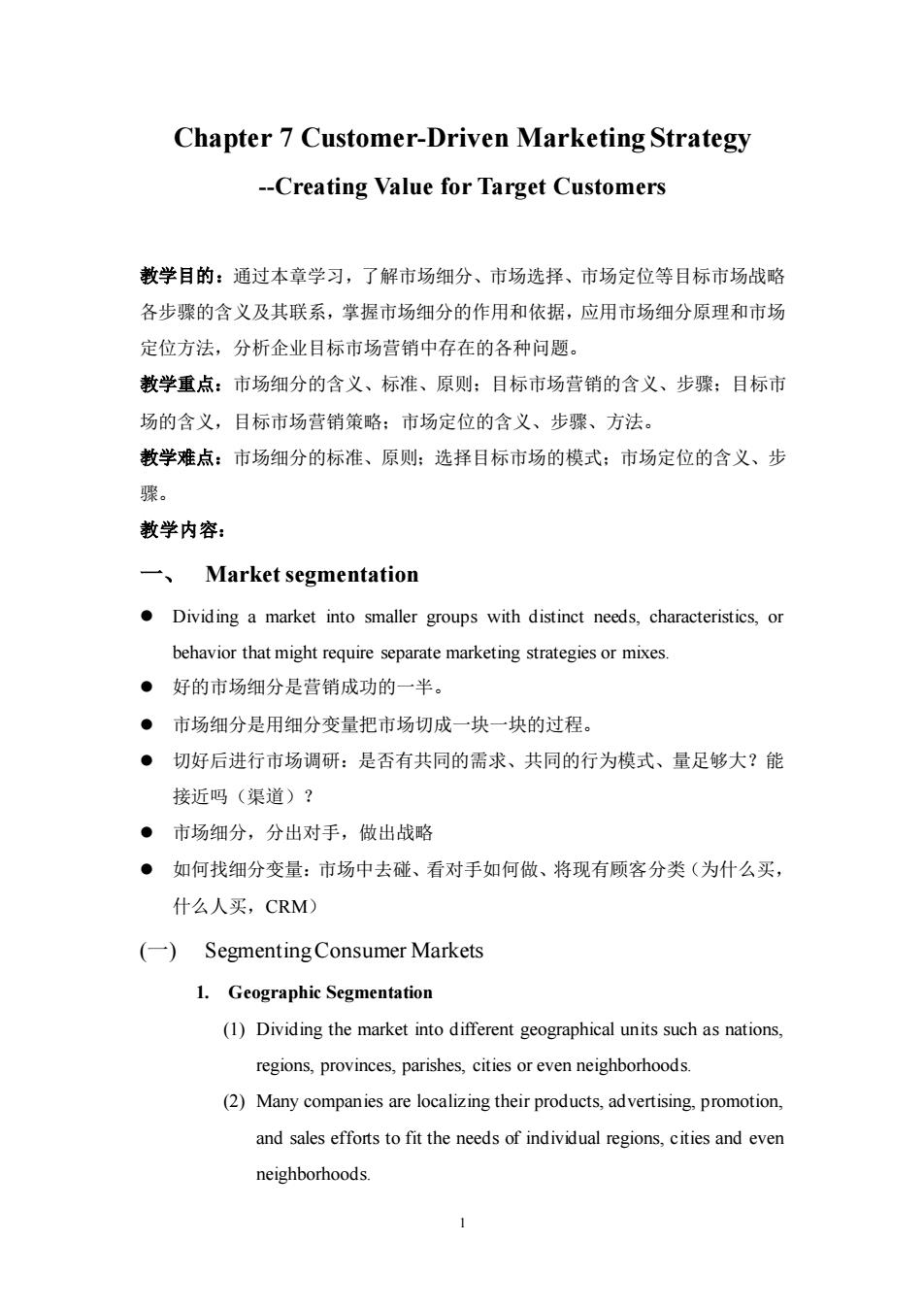
Chapter 7 Customer-Driven Marketing Strategy -Creating Value for Target Customers 教学目的:通过本章学习,了解市场细分、市场选择、市场定位等目标市场战略 各步骤的含义及其联系,掌握市场细分的作用和依据,应用市场细分原理和市场 定位方法,分析企业目标市场营销中存在的各种问题。 教学重点:市场细分的含义、标准、原则:目标市场营销的含义、步骤:目标市 场的含义,目标市场营销策略:市场定位的含义、步骤、方法。 教学难点:市场细分的标准、原则:选择目标市场的模式:市场定位的含义、步 骤。 教学内容: 一、Market segmentation Dividing a market into smaller groups with distinct needs,characteristics,or behavior that might require separate marketing strategies or mixes. ·好的市场细分是营销成功的一半。 ·市场细分是用细分变量把市场切成一块一块的过程。 ·切好后进行市场调研:是否有共同的需求、共同的行为模式、量足够大?能 接近吗(渠道)? ·市场细分,分出对手,做出战略 ·如何找细分变量:市场中去碰、看对手如何做、将现有顾客分类(为什么买, 什么人买,CRM (一)Segmenting Consumer Markets 1.Geographic Segmentation (1)Dividing the market into different geographical units such as nations. regions,provinces,parishes,cities or even neighborhoods. (2)Many companies are localizing their products,advertising.promotion, and sales efforts to fit the needs of individual regions,cities and even neighborhoods
1 Chapter 7 Customer-Driven Marketing Strategy -Creating Value for Target Customers 教学目的:通过本章学习,了解市场细分、市场选择、市场定位等目标市场战略 各步骤的含义及其联系,掌握市场细分的作用和依据,应用市场细分原理和市场 定位方法,分析企业目标市场营销中存在的各种问题。 教学重点:市场细分的含义、标准、原则;目标市场营销的含义、步骤;目标市 场的含义,目标市场营销策略;市场定位的含义、步骤、方法。 教学难点:市场细分的标准、原则;选择目标市场的模式;市场定位的含义、步 骤。 教学内容: 一、 Market segmentation ⚫ Dividing a market into smaller groups with distinct needs, characteristics, or behavior that might require separate marketing strategies or mixes. ⚫ 好的市场细分是营销成功的一半。 ⚫ 市场细分是用细分变量把市场切成一块一块的过程。 ⚫ 切好后进行市场调研:是否有共同的需求、共同的行为模式、量足够大?能 接近吗(渠道)? ⚫ 市场细分,分出对手,做出战略 ⚫ 如何找细分变量:市场中去碰、看对手如何做、将现有顾客分类(为什么买, 什么人买,CRM) (一) Segmenting Consumer Markets 1. Geographic Segmentation (1) Dividing the market into different geographical units such as nations, regions, provinces, parishes, cities or even neighborhoods. (2) Many companies are localizing their products, advertising, promotion, and sales efforts to fit the needs of individual regions, cities and even neighborhoods
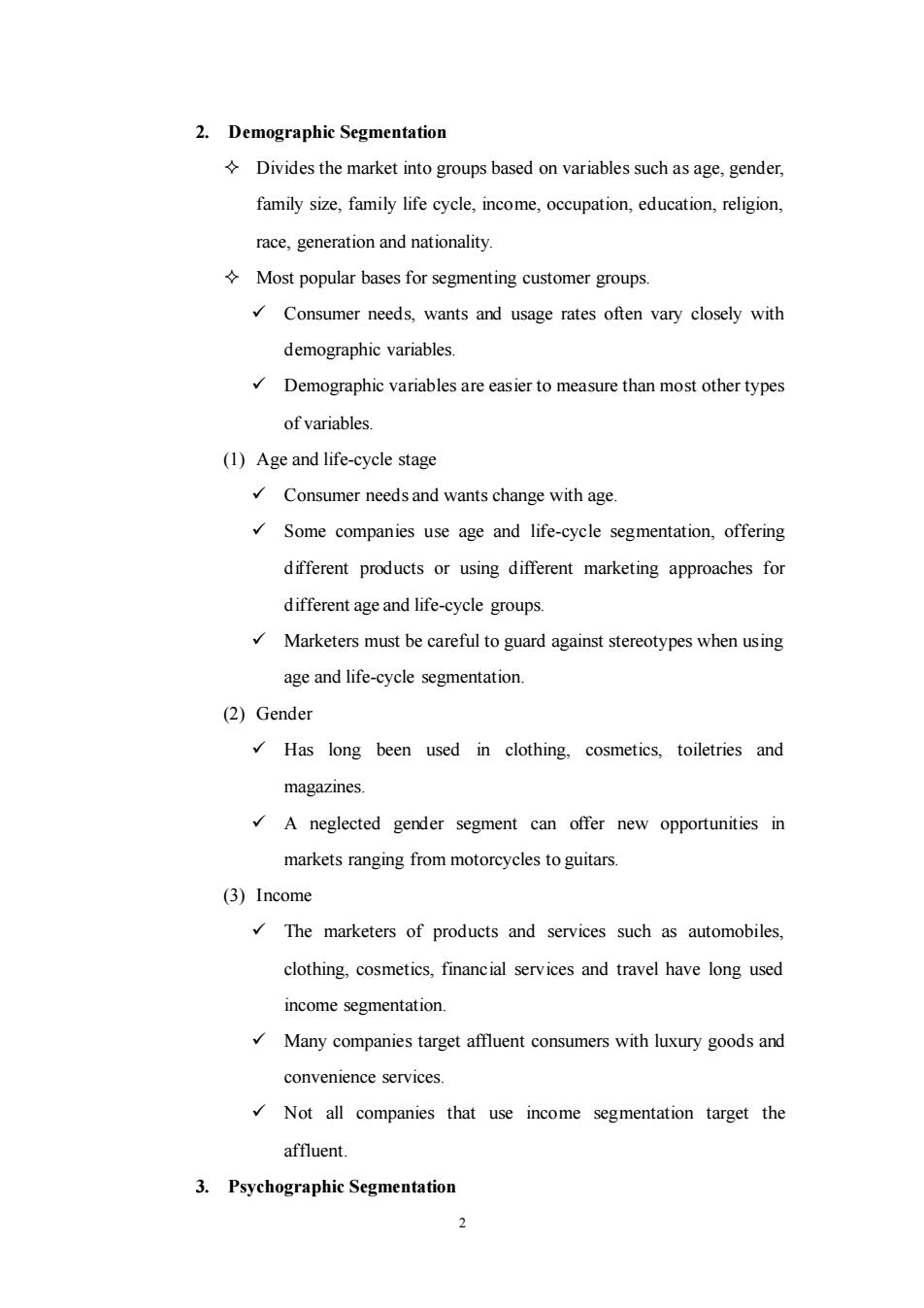
2.Demographic Segmentation Divides the market into groups based on variables such as age.gender. family size,family life cycle,income,occupation,education,religion race,generation and nationality. Most popular bases for segmenting customer groups. Consumer needs,wants and usage rates often vary closely with demographic variables Demographic variables are easier to measure than most other types of variables. (1)Age and life-cycle stage Consumer needs and wants change with age. Some companies use age and life-cycle segmentation,offering different products or using different marketing approaches for different age and life-cycle groups. Marketers must be careful to guard against stereotypes when using age and life-cycle segmentation. (2)Gender Has long been used in clothing.cosmetics,toiletries and magazines. A neglected gender segment can offer new opportunities in markets ranging from motorcycles to guitars (3)Income The marketers of products and services such as automobiles, clothing.cosmetics,financial services and travel have long used income segmentation Many companies target affluent consumers with luxury goods and convenience services Not all companies that use income segmentation target the affluent. 3.Psychographic Segmentation
2 2. Demographic Segmentation Divides the market into groups based on variables such as age, gender, family size, family life cycle, income, occupation, education, religion, race, generation and nationality. Most popular bases for segmenting customer groups. ✓ Consumer needs, wants and usage rates often vary closely with demographic variables. ✓ Demographic variables are easier to measure than most other types of variables. (1) Age and life-cycle stage ✓ Consumer needs and wants change with age. ✓ Some companies use age and life-cycle segmentation, offering different products or using different marketing approaches for different age and life-cycle groups. ✓ Marketers must be careful to guard against stereotypes when using age and life-cycle segmentation. (2) Gender ✓ Has long been used in clothing, cosmetics, toiletries and magazines. ✓ A neglected gender segment can offer new opportunities in markets ranging from motorcycles to guitars. (3) Income ✓ The marketers of products and services such as automobiles, clothing, cosmetics, financial services and travel have long used income segmentation. ✓ Many companies target affluent consumers with luxury goods and convenience services. ✓ Not all companies that use income segmentation target the affluent. 3. Psychographic Segmentation
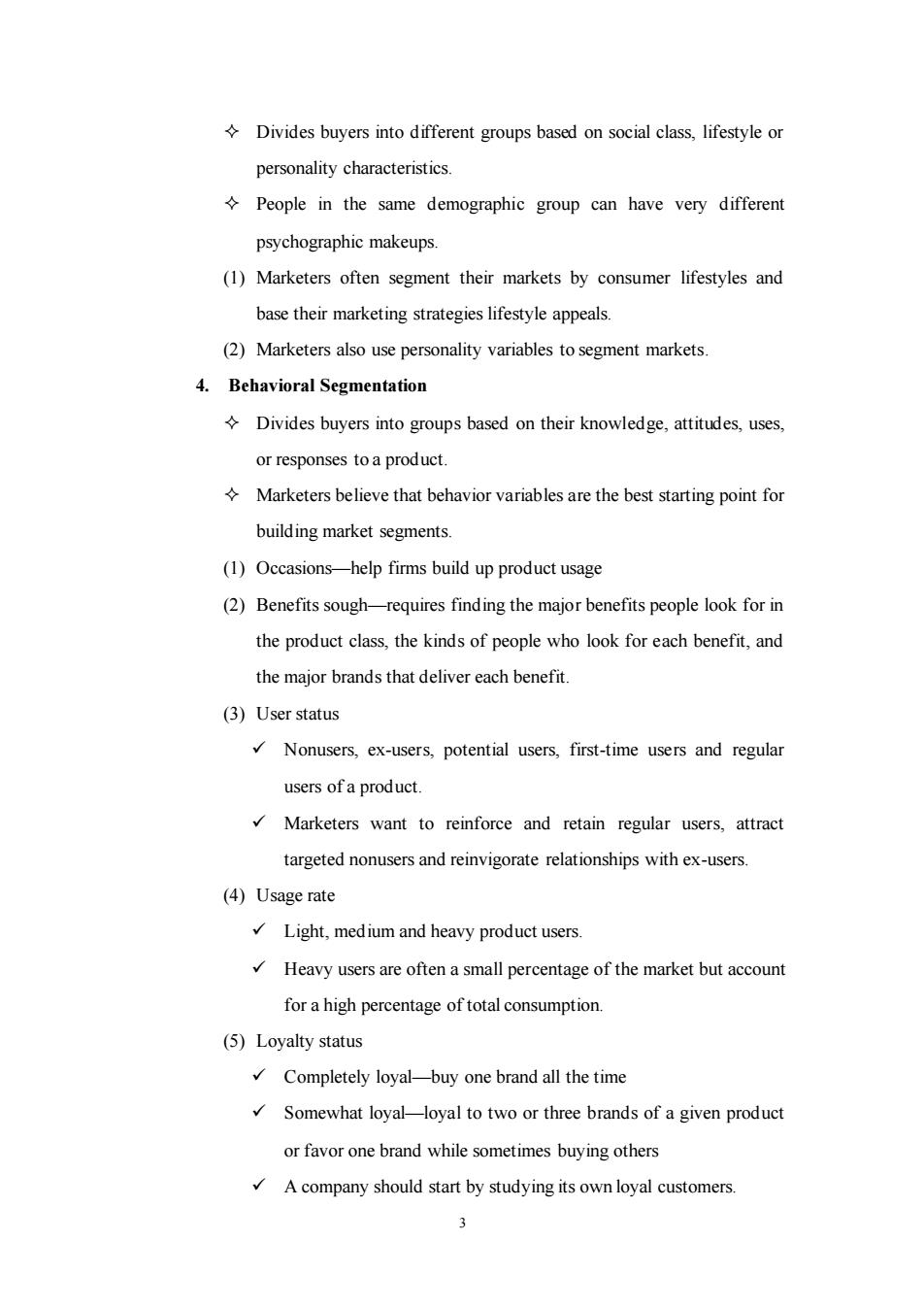
Divides buyers into different groups based on social class,lifestyle or personality characteristics. People in the same demographic group can have very different psychographic makeups. (1)Marketers often segment their markets by consumer lifestyles and base their marketing strategies lifestyle appeals. (2)Marketers also use personality variables to segment markets 4.Behavioral Segmentation Divides buyers into groups based on their knowledge,attitudes,uses. or responses toa product. Marketers believe that behavior variables are the best starting point for building market segments. (1)Occasions-help firms build up product usage (2)Benefits sough-requires finding the major benefits people look for in the product class,the kinds of people who look for each benefit,and the major brands that deliver each benefit. (3)User status Nonusers,ex-users,potential users,first-time users and regular users of a product. Marketers want to reinforce and retain regular users,attract targeted nonusers and reinvigorate relationships with ex-users (4)Usage rate Light,medium and heavy product users. Heavy users are often a small percentage of the market but account for a high percentage of total consumption (⑤)Loyalty status Completely loyal-buy one brand all the time Somewhat loyal-loyal to two or three brands of a given product or favor one brand while sometimes buying others A company should start by studying its own loyal customers. 3
3 Divides buyers into different groups based on social class, lifestyle or personality characteristics. People in the same demographic group can have very different psychographic makeups. (1) Marketers often segment their markets by consumer lifestyles and base their marketing strategies lifestyle appeals. (2) Marketers also use personality variables to segment markets. 4. Behavioral Segmentation Divides buyers into groups based on their knowledge, attitudes, uses, or responses to a product. Marketers believe that behavior variables are the best starting point for building market segments. (1) Occasions—help firms build up product usage (2) Benefits sough—requires finding the major benefits people look for in the product class, the kinds of people who look for each benefit, and the major brands that deliver each benefit. (3) User status ✓ Nonusers, ex-users, potential users, first-time users and regular users of a product. ✓ Marketers want to reinforce and retain regular users, attract targeted nonusers and reinvigorate relationships with ex-users. (4) Usage rate ✓ Light, medium and heavy product users. ✓ Heavy users are often a small percentage of the market but account for a high percentage of total consumption. (5) Loyalty status ✓ Completely loyal—buy one brand all the time ✓ Somewhat loyal—loyal to two or three brands of a given product or favor one brand while sometimes buying others ✓ A company should start by studying its own loyal customers
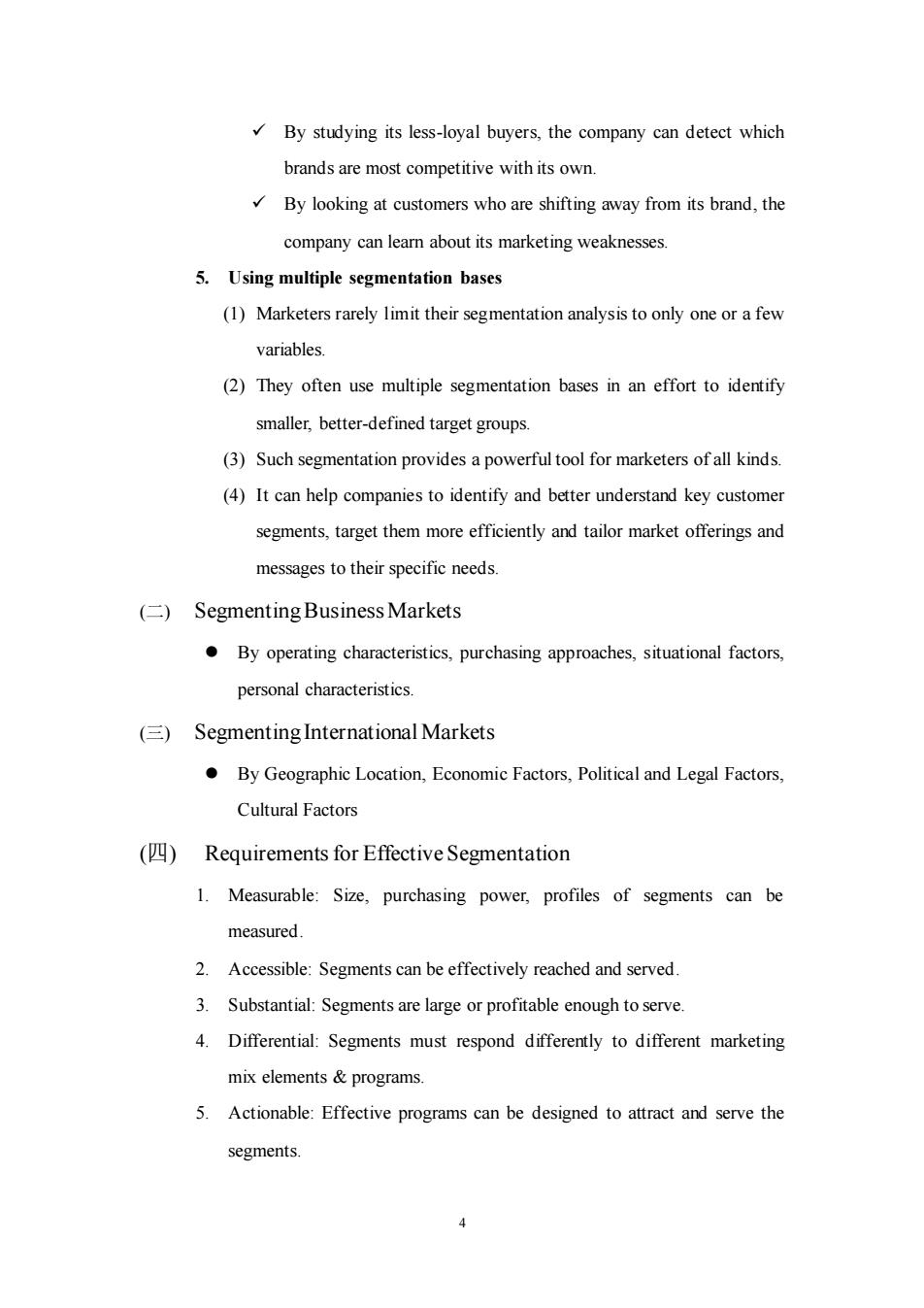
By studying its less-loyal buyers,the company can detect which brands are most competitive with its own. By looking at customers who are shifting away from its brand,the company can leam about its marketing weaknesses. 5.Using multiple segmentation bases (1)Marketers rarely limit their segmentation analysis to only one or a few variables (2)They often use multiple segmentation bases in an effort to identify smaller,better-defined target groups. (3)Such segmentation provides a powerful tool for marketers of all kinds. (4)It can help companies to identify and better understand key customer segments,target them more efficiently and tailor market offerings and messages to their specific needs. ()Segmenting Business Markets By operating characteristics,purchasing approaches,situational factors, personal characteristics. (=Segmenting International Markets By Geographic Location,Economic Factors,Political and Legal Factors, Cultural Factors (Requirements for Effective Segmentation 1.Measurable:Size,purchasing power,profiles of segments can be measured. 2.Accessible:Segments can be effectively reached and served. 3.Substantial:Segments are large or profitable enough to serve 4.Differential:Segments must respond differently to different marketing mix elements programs. 5.Actionable:Effective programs can be designed to attract and serve the segments
4 ✓ By studying its less-loyal buyers, the company can detect which brands are most competitive with its own. ✓ By looking at customers who are shifting away from its brand, the company can learn about its marketing weaknesses. 5. Using multiple segmentation bases (1) Marketers rarely limit their segmentation analysis to only one or a few variables. (2) They often use multiple segmentation bases in an effort to identify smaller, better-defined target groups. (3) Such segmentation provides a powerful tool for marketers of all kinds. (4) It can help companies to identify and better understand key customer segments, target them more efficiently and tailor market offerings and messages to their specific needs. (二) Segmenting Business Markets ⚫ By operating characteristics, purchasing approaches, situational factors, personal characteristics. (三) Segmenting International Markets ⚫ By Geographic Location, Economic Factors, Political and Legal Factors, Cultural Factors (四) Requirements for Effective Segmentation 1. Measurable: Size, purchasing power, profiles of segments can be measured. 2. Accessible: Segments can be effectively reached and served. 3. Substantial: Segments are large or profitable enough to serve. 4. Differential: Segments must respond differently to different marketing mix elements & programs. 5. Actionable: Effective programs can be designed to attract and serve the segments
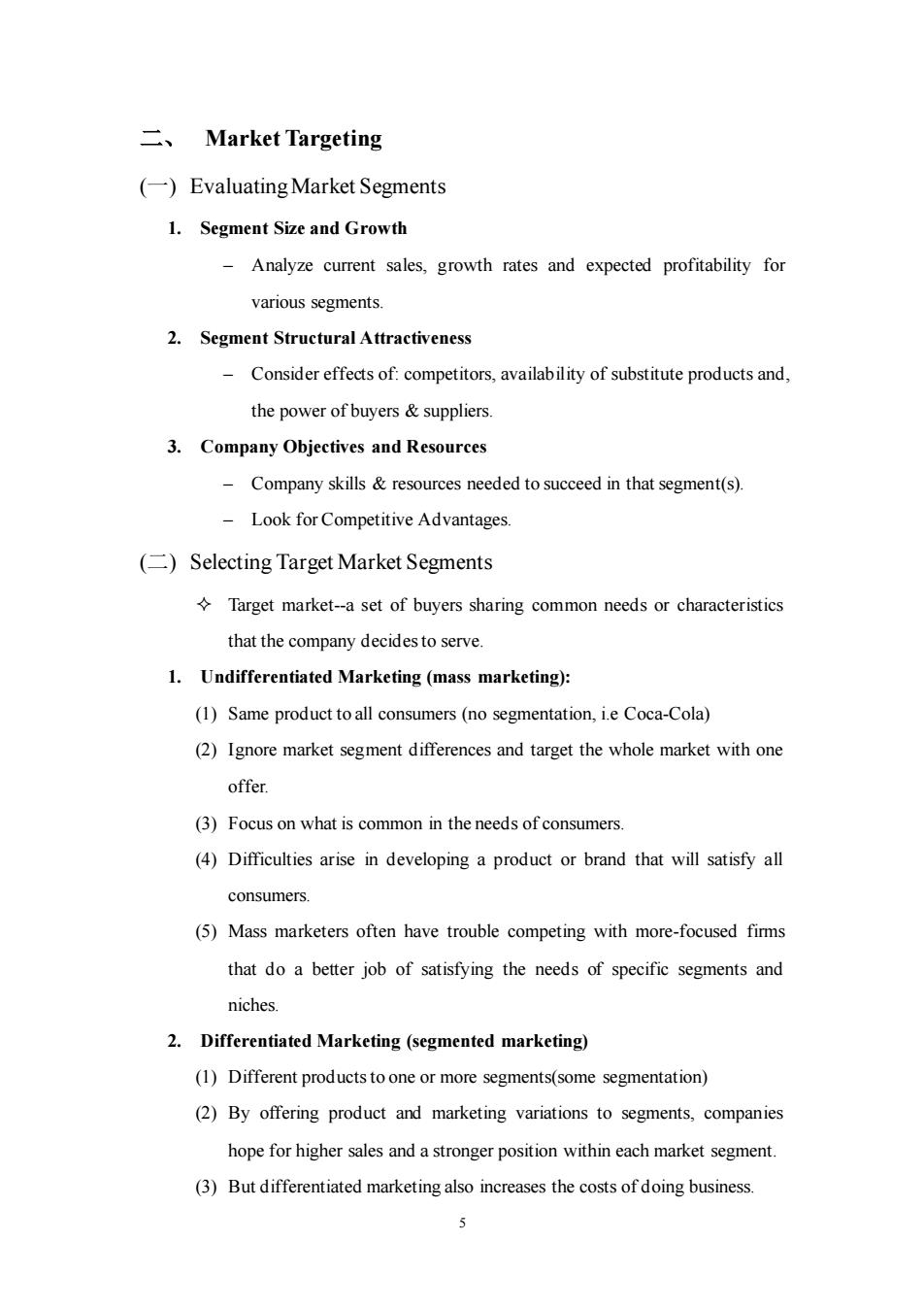
二、Market Targeting (-)Evaluating Market Segments 1.Segment Size and Growth -Analyze current sales,growth rates and expected profitability for various segments 2.Segment Structural Attractiveness Consider effects of competitors,availability of substitute products and the power of buyers suppliers. 3.Company Objectives and Resources -Company skills&resources needed to succeed in that segment(s) Look for Competitive Advantages. ()Selecting Target Market Segments Target market-a set of buyers sharing common needs or characteristics that the company decides to serve. 1.Undifferentiated Marketing(mass marketing): (1)Same product toall consumers(no segmentation,i.e Coca-Cola) (2)Ignore market segment differences and target the whole market with one offer. (3)Focus on what is common in the needs of consumers. (4)Difficulties arise in developing a product or brand that will satisfy all consumers. (5)Mass marketers often have trouble competing with more-focused fimms that do a better job of satisfying the needs of specific segments and niches 2.Differentiated Marketing(segmented marketing) (1)Different products to one or more segments(some segmentation) (2)By offering product and marketing variations to segments,companies hope for higher sales and a stronger position within each market segment (3)But differentiated marketing also increases the costs of doing business
5 二、 Market Targeting (一) Evaluating Market Segments 1. Segment Size and Growth – Analyze current sales, growth rates and expected profitability for various segments. 2. Segment Structural Attractiveness – Consider effects of: competitors, availability of substitute products and, the power of buyers & suppliers. 3. Company Objectives and Resources – Company skills & resources needed to succeed in that segment(s). – Look for Competitive Advantages. (二) Selecting Target Market Segments Target market-a set of buyers sharing common needs or characteristics that the company decides to serve. 1. Undifferentiated Marketing (mass marketing): (1) Same product to all consumers (no segmentation, i.e Coca-Cola) (2) Ignore market segment differences and target the whole market with one offer. (3) Focus on what is common in the needs of consumers. (4) Difficulties arise in developing a product or brand that will satisfy all consumers. (5) Mass marketers often have trouble competing with more-focused firms that do a better job of satisfying the needs of specific segments and niches. 2. Differentiated Marketing (segmented marketing) (1) Different products to one or more segments(some segmentation) (2) By offering product and marketing variations to segments, companies hope for higher sales and a stronger position within each market segment. (3) But differentiated marketing also increases the costs of doing business